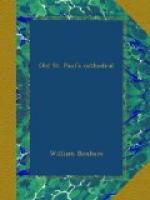Another bishop of these early times was Theodred, who was named “the Good.” We cannot give the exact dates of his episcopate, further than that he was in the See in the middle of the tenth century, as is shown by some charters that he witnessed. There is a pathetic story told of him that on his way from London to join King Athelstan in the north he came to St. Edmund’s Bury, and found some men who were charged with robbing the shrine of St. Edmund, and were detected by the Saint’s miraculous interference. The bishop ordered them to be hanged; but the uncanonical act weighed so heavily on his conscience that he performed a lifelong penance, and as an expiation reared a splendid shrine over the saint’s body. And further, he persuaded the King to decree, in a Witanagemote, that no one younger than fifteen should be put to death for theft. The bishop was buried in the crypt of St. Paul’s, and the story was often told at his tomb, which was much frequented by the citizens, of his error and his life-long sorrow.
Another bishop who had been placed in the See by Edward the Confessor, who, it will be remembered, greatly favoured Normans, to the indignation of the English people, was known as “William the Norman,” and, unpopular as the appointment may have been, it did the English good service. For when the Norman Conquest came the Londoners, for a while, were in fierce antagonism, and it might have gone hard with them. But Bishop William was known to the Conqueror, and had, in fact, been his chaplain, and it was by his intercession that he not only made friends with them, but gave them the charter still to be seen at the Guildhall. His monument was in the nave, towards the west end, and told that he was “vir sapientia et vitae sanctitate clarus.” He was bishop for twenty years, and died in 1075. The following tribute on the stone is worth preserving:—
“Haec tibi, clare Pater, posuerunt
marmora cives,
Praemia non meritis aequiparanda tuis:
Namque sibi populus te Londoniensis amicum
Sensit, et huic urbi non leve presidium:
Reddita Libertas, duce te, donataque multis,
Te duce, res fuerat publica muneribus.
Divitias, genus, et formam brevis opprimat
hora,
Haec tua sed pietas et benefacta manent."[1]




